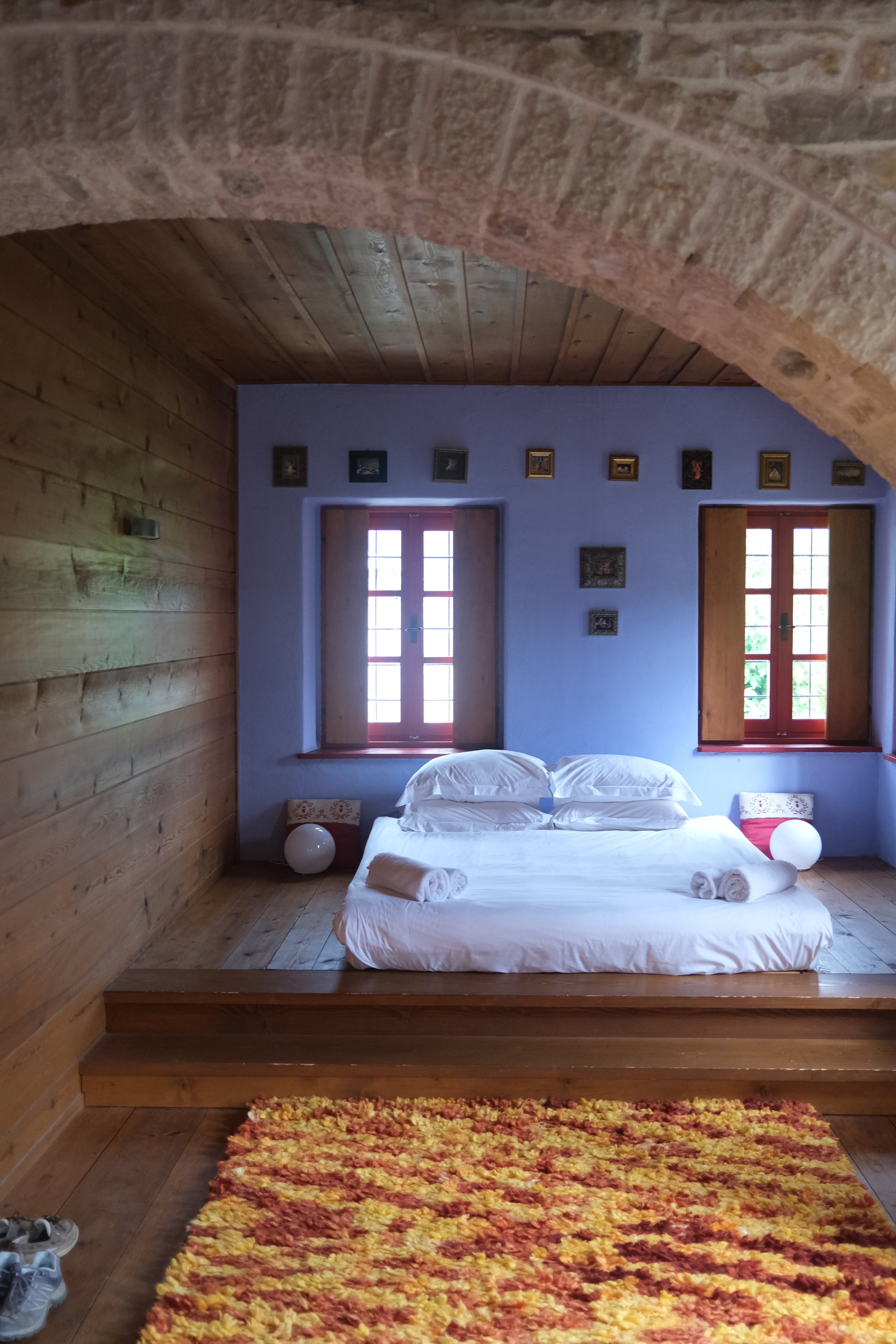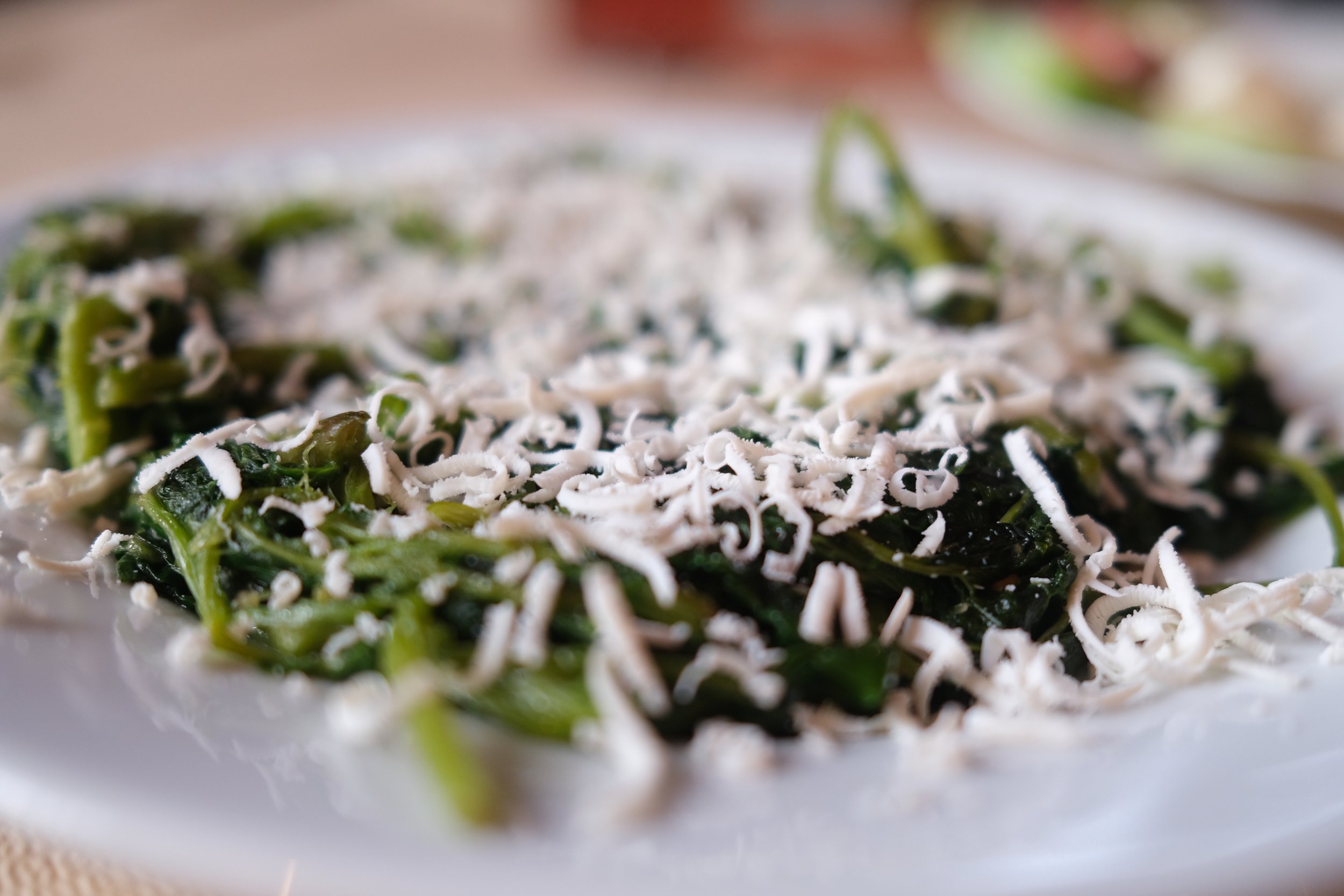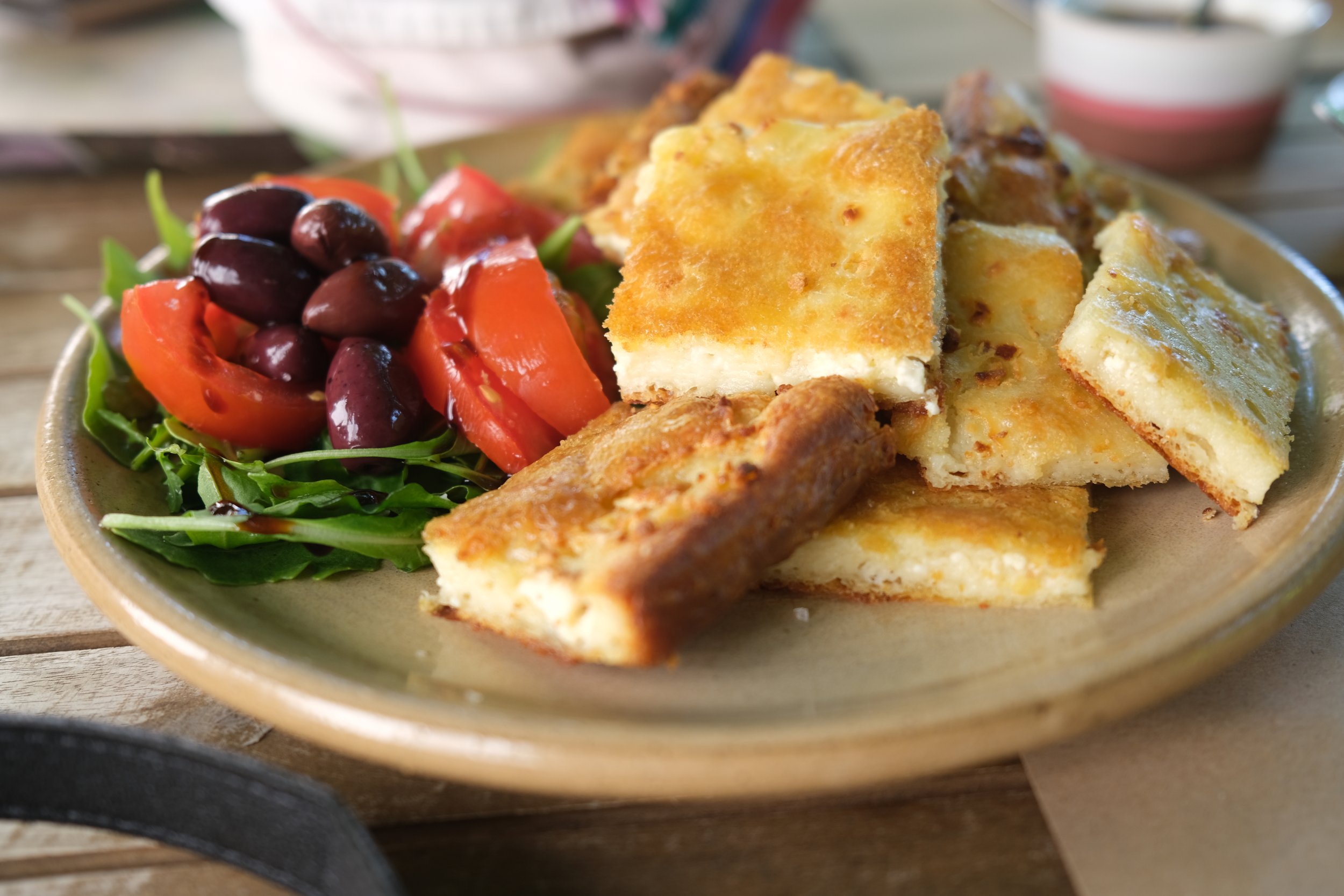“What an honour to, just for a few days, be part of this secret.”
Anemi guesthouse and its village Kato Pedina (Κατο Πεδινα) - Epirus, Greece.
How to describe Anemi without using certain image-producing lexical options like ‘hippy’ or ‘bohemian’, whilst encapsulating elements of both. Anemi was neither exactly; it is a bed and breakfast guesthouse in Kato Pedina, a historic, mostly abandoned mountainous village a stone’s throw from the plateau below, 940m above sea level, in the Zagori region of Epirus. This area is mildly more frequented by international tourists than its higher counterparts, but the British still provided a welcome elision- there is something about savouring these somehow still alive magical snapshots of history, albeit not my national history, without the hoards of tourists one normally witnesses in hotspots. This creates somewhat of an oxymoron in my mental wanderings between the desire to see such dishevelled, dilapidated dwellings once again brought to life by a wealth of characters, long-term residents, shop owners, local craftspeople, and tavernas, supported by the tourists pouring money into these villages, versus the desire to appreciate them without feeling embarrassed by a British or American tourist asking if the can have chips instead of the miraculous local delights on the verbal taverna menu. Without also the health and safety precautions requiring any still dilapidated buildings to be encircled in red plastic meshing with a ‘danger’ or ‘warning’ sign perched more rigidly into the ground than the building it is meant to warn against, and without the area changing its local history, foods and traditions to the whims of tourists. How fabulous if there could be a mix of enough tourists who appreciate true authenticity, on the hunt to discover landscapes, traditions, foods, and experiences they would not find at home, with a desire to become part of yester year, and bringing in enough money to the village allowing locals to stay in their houses or have impetus to return to them from their new, more lucrative city lives. Anyway, I digress… Anemi is a guesthouse comprising 2 renovated village houses midway up the hill in Kato Pedina. Whilst skilful driving and a particularly stout handbrake will allow your car to park below the house (requiring only 20 yards cobble-striken upwards traverse), it is best to leave it in the carpark which you cannot fail to miss, a right hand turn off the main track; this is a carpark which, upon entering you may question its particularly capacious dimensions, but if you are able to visit the area during August’s festival season, then you will soon understand. Incidentally, the festival season in Greece, occurring every August, where music, food and dancing take centre stage and one of the only times a year where normally abandoned villages regain vitality and inhabitants, is one of the few authentic occasions fairly untapped by international tourism.
From my perspective, Anemi provided a most seamless combination of artsy x traditional x authentic x tasteful. Think boho-chic meets traditional stone fort, and with doors which you have to lift when opening them to prevent the entire village being woken each time you enter or exit the room. One thing I could not fathom was the presence of bars at each window on every building. It transpires that these, as with everything in these historic villages, have a story, but it was not until the afternoon of the following day when visiting Rokka in Elefotopos, that the answer was revealed. Back in the 17-1800s, the men from these villages travelled abroad (often to Serbia) with hopes of more lucrative business prospects, and the women, children and elderly were left together. Being such, they felt some protection was required, hence the high walls around some houses (also for privacy) and the window bars, preventing any unwanted guests, human or otherwise (don’t forget this is bear country!).






We arrived at the outbreak of the most powerful electric storm I have witnessed in my 30 years on planet Earth, with clamorous crackles of thunder powerful enough to break your eardrums… at least that’s how it felt. Once in and safe from this murderous sky which pulsated cyclically around the plateau for what seemed like hours, Anemi provided a cosy sanctitude against the stentorian abyss. But we couldn’t quite battle down the hatches and wait for the storm to pass, mimicking our feathery companions using our outer windowsills as shelter, as we needed FOOD! We became lost on our way from Anemi to the village square further down the hill. Having not recced the village in daylight to suss useful to know locations, we huddled under our small one-person umbrella, skating across polished cobbles mosaiced with weeds and grasses. Left out of the Anemi gate, up a narrow grass flanked twitten (‘surely this is home to snakes?’ ‘yes, probably. Just walk quickly!’) and up into a large flat area with the token large walnut tree signalling changes in level, with a church towering over us built upon higher ground. No taverna here. Weaving through another couple of surely snake infested labyrinths, we were greeted by 2 Greek mountain dogs as we reached the village square. Now, when I say ‘greeted’… just to give some context, the Greeks have a completely different view of pet dogs as we do in the UK: there is no such notion of keeping your animal within the confines of your property and as such you will witness many dogs simply walking the streets of villages, towns or even cities (although, there are of course many stray dogs also); the problem occurs if you have the misfortune to accidently come within a distance of its property which the dog finds unacceptable- then you require quick thinking, dog taming skills, and a decent sprinting pace (I joke: running away from a dog will always worsen the situation), but once retreating to a distance the dog is happy with (which usually isn’t far), you are once again safe to roam as you please. Couple this with the fact that most of these larger dogs, Greek mountain dogs or otherwise, are livestock animals, and when not working, they are left to roam. Unless you are within a stone’s-throw of their guarded livestock, they will generally leave you alone; in our case however, upon our theatrical non-subtle trip over a set of large, raised stones into the village square, they wanted a cuddle. And by the time a mountain dog reaches within 10 feet of you and starts to bark, there is little point in contemplating an escape- you will either gain catastrophic injuries/be torn limb from limb (I jest) or you will be cuddled. And fear not, fleas are not a problem in central Greece, so cuddle any demanding feline or canine to your heart’s content. As the Greeks habitually enjoy evening meals later than us Anglo-saxons, our 20.30 entry to the village’s one taverna was considered normal.
The taverna, decorated with orange-pink walls and ceiling with line green window wall surrounds, with light blue window panes, was surprisingly not as psychedelic as it reads. A large woodburner dominated the attention given to the room, with its linked exposed wide copper pipe running just shy of the ceiling. Small artworks by Klimt, Freida Kahlo, Klee and others provided more entertainment for the eyes, and a satisfying game of guess the artist. The floor itself was home only to a series of tables and chairs, with no rugs to dampen the raucous noise of its two dinner guests. Like many rural or less touristy areas of Greece, the taverna owners generally are open to a chat, they enjoy learning about you and what made you choose such an untapped area to stay, they are excited to impart their local knowledge of food, history, places to visit, places to eat, families to knock on the door of, and generally ends up in a comparison between such a rural life and the normal life of an Anglo-saxon. So, oblige, take the time, ask them questions; after all, why are you here if not to learn more about this utter antithesis to normal life?
Here again, the menu (καταλογος- catalogos- clever, eh?) was verbal. Of the local red wines on offer, dry red or sweet red were available. Now, Greek wines are something exported in very limited quantities and generally unknown by international consumers. In some ways I perceive this as a good thing, as then the only way of enjoying these potable local masterpieces is authentically, with the perfect accompanying sustenance in a perfect setting. However, the world is definitely missing out. As my mother attests ‘these are the only wines which don’t give me a headache’ and she’s right- they could not be more natural. Being fond of sweeter wines, we opted for the sweet red, lacking the warm winter cuddle of a dessert wine and lighter in colour- almost ribena- but undoubtedly sweet. Our host described the location of its production, on the flat vineyards close to the lake in Ioannina (being only a few kms away, this was still possibly the furthest distance we had drunk wine from its source in Greece).




The food of the day, prepared in the kitchen with a casual view of the plateau beneath and mountains in the distance (you start to become used to these majestic sites), was Greek salad, gramos greens from the mountain above (like wild spinach but grown at 1500m altitudes) with local cheese, mushroom pita, beef burgers (but not as you know them), pancetta or sausage. Our selection did not disappoint. As is usual, each arrived when it was ready, irrespective of any general order of dishes or title of starter or main. The sausage was handmade and akin to the flavour of chorizo although not in looks and not as dense, and served with potato ‘chips’ and homemade mustard- perfect with the greens; but forget what you have experienced in the chip or mustard categories- the mustard had the strength of horseradish but somehow honey was the dominant flavour. Unfortunately, I became too engrossed in consuming these local specialities that I completely forgot to photograph the sausage! As we ate, the mountain dog sat on the bench beneath the taverna window facing the square, positioning himself to gaze through the rain-streaked glass at us- although stray cats are a common occurrence in tavernas in Greece, dogs are not, and so outside he remained. The tomatoes had life, the cucumber had flavour (I generally avoid them at home unless accompanied by an unhealthy portion of dip or something more flavoursome, making you feel marginally less guilty consuming the dip) and a distinct flavour at that- it was fresh, half mint, half spinach flavour, not watery, and with a strong composition- in all other respects it resembled a cucumber so I’m inclined to believe I was not the victim of misrepresentation but had merely not tasted a proper example before! Our dessert was brought irrespective of asking and proved to be figs in syrup. Figs grow prolifically here, even high in the mountains, so it was no surprise, but they taste less sweet, requiring them to be preserved in syrup. The glistening black cannonball droplet tasted more of aniseed than fig and was definitely an acquired taste!
Anemi breakfast- wow! My eyes were as satisfied as my tastebuds! We sat under the tree canopy, the new kittens skittish around us, cats lazily draping themselves over chairs, and the dog Rico generally wandering around looking for hugs… and food… mainly food. Not many people can say they’ve had breakfast 900+m up a mountain in summer clothes, drinking Greek coffee overlooking a wide vast expanse of plateau where you can just make out a shepherd his flock and a few salt and pepper coloured darts, with majestic mountains covered in green tree splodges behind which would dwarf Scarfell Pike. What an honour to, just for a few days, be part of this secret. This was my first experience of alevropita and I rather think I started with the best. Essentially a thin eggy-bread with feta, this simple yet masterful snack had a crème brulee light and satisfying snap to its skin from whence your tongue instantaneously tingles with the feta found inside, and cuddled with the familiar warmth of its eggy surroundings. An assortment of homemade jams were placed separately on the table: plum, strawberry, orange (but less tangy than marmalade), and honey (from velanithi); fresh bread with a corresponding fresh warm waft lying wrapped in a traditionally patterned cloth in a basket was to provide the platform upon which to drip these sweet glutinous liquids. Sheep butter adorned the table also- well worth a try! These offerings would have been sufficient for even the mountain goat of a walker, yet another dish came. From a distance one might have mistaken it for a particularly dense pavlova but upon this platter was instead the most delightful presentation of fresh chopped peach, cherries, banana (the only non-local ingredient) and raisins, a mountain of Greek yoghurt, adorned with honey, hazelnuts, walnuts and plenty of cinnamon, with lokamades on the side for good measure. For those unfamiliar with this term, these are similar to doughnuts but less doughy inside, airier, but with a richer tasting batter, in this instance dusted with sugar. The honey and cinnamon formed the most delicious layer- a comforting Christmas flavour which made clusters of the hazelnuts. Our stomachs proved of insufficient capacity to polish off all the breakfast delights, and so our hosts placed the rest in silver foil for us to enjoy in the day- the lokumades were very welcome indeed post-walk before we could find a café later on.
Seeing the village in the light of day proved a treat for botanists, with fabulous examples of wide-girthed platanos (like maple trees) hundreds of years old, fig trees, vines, walnut trees, with poppies and elderflower taking over the lower levels, like someone peppered the landscape with red and white, sprinkles which stick to areas of the page, much like the glitter you used to sprinkle over a card dabbed with glue. The whole place was alive with the coo of cuckoos, general bird chirp chatter (excuse my ignorance on bird calls!), swallows darting between trees as if playing a game of long-distance netball, bells clanged around the necks of sheep, goats, and cows on the plain below. Walking the paths, generally overgrown with weeds, nettles, poppies, and watching out for snakes, we explored this mysteriously antiquated village, which, upon inspection was more alive with human activity than we first thought. Children played together, and giggled seeing us run from 2 very good guard dogs (we were assured they would not bite but we didn’t want to take the risk!). A motorcross fanatic returned home, bike in tow, and chatted with a neighbour. Houses, some with their imposing doors still intact, locked still, and connected to a creeper clad wall, but when seen from the side, only the frontage remained, the side walls and roof clinged to and pulled down by green, leggy flora into the snake infested jungle.
For some reason, everything smells more strongly here- flowers, trees, fruits all have more pungency than in the UK- the air constantly provides you with another scent. Be warned though, the use of the word ‘snakes’ throughout this piece is not for dramatic effect. Snakes tend to inhabit the long grasses so it is best to wear closed shoes around these villages; even over cobbles where long grasses have not been strimmed, long trousers are recommended. We saw two whilst there and they are not small! Startling one can lead to a rather painful bite and a likely hospital visit (although are not fatal). But don’t let that put you off; it’s just a question of commonsense, a skill possessed even by young children in these parts. The area is well worth the exploration and appreciation- especially as (with the mix of smells, architecture, natural beauty and mountains, flora and fauna, weather, people, activities and food) you are unlikely to find anywhere else like it on Earth. This village, indeed this area, is a gem, and I cannot wait to return.




















